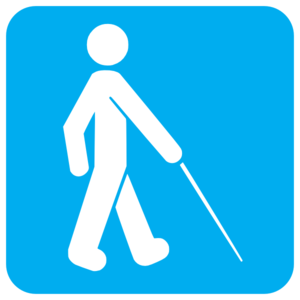Photo: William Vandry with blind children from the Texas School of the Blind 2014
“I have taught many clinics with the blind, and at Criss Cole over the years, and if there is one goal I intend to accomplish with blind students, the message is to not allow you to be immersed in self-pity, or hopelessness. This type of motivation is not just for blind people. We have so many people in the USA that have ups and downs that need this lesson instilled as well. I think I succeeded when my wife and I along with my awesome students who volunteered to assist got to train with staffers and blind students. What is so awesome is that after the training, everyone forgot who was blind and who was not. We all have the same sight training Jiu-jitsu.”
- William Vandry, 2012
October is White Cane Safety Awareness Month, to raise understanding and awareness of orientation and mobility tools for individuals who are blind and visually impaired.
William and Chandra and Vandry Hope volunteers working with blind students on Jiujitsu lessons at Texas School of the Blind 2013.
William and Chandra and Vandry Hope volunteers working with blind students on Jiujitsu lessons at Texas School of the Blind 2014.
About White Cane Law
The white cane allows a person who is blind to travel independently. In 1931, Lions Clubs began promoting the use of white canes for people who are blind as a national identification program. All states and many other countries have White Cane laws, which allow pedestrians who are legally blind the right of way at street crossings.
In recognition of International White Cane Day, here are a few guidelines regarding how to interact with someone who is blind or visually impaired:
- When in doubt, ask if the person needs assistance.
- Do not grab the person, cane or dog guide.
- Do not pet a dog guide. Most dog guides are working & should not be petted since it can be distracting for the dog.
- Identify yourself when you come in to a room and let the person know when you are leaving a room or location.
- When you speak about someone with a disability, refer to the person and then to the disability. For example, refer to “a person who is blind” rather than to “a blind person.”
- Always yield to white cane and dog guide users at street crossings.
White cane is a point for the blind. However, respecting the blind, and all forms of blindness are pivotal as well. I have worked with the legally blind since 1997. Visual impairment is a subject few in the martial arts discuss. When people develop visual handicaps, it is truly a very challenging setback in life. What many do not know is how people develop blindness. Let’s begin with a few statistics.
The World health organization statistics on legally blind and visually impaired show:
- 285 million people are visually impaired worldwide: 39 million are blind and 246 have low vision.
- About 90% of the world’s visually impaired live in developing countries.
- Globally, uncorrected refractive errors are the main cause of visual impairment; cataracts remain the leading cause of blindness in middle- and low-income countries.
- The number of people visually impaired from infectious diseases has greatly reduced in the last 20 years
- 80% of all visual impairment can be avoided or cured
- Diabetic retinopathy: associated with diabetes.
- Blinding trachoma: bacterial condition causing painful scarring in the cornea.
- Eye conditions in children such as cataract, retinopathy of prematurity, and vitamin A deficiency.
- Onchocerciasis (river blindness): a parasitic disease caused by filarial worms and transmitted through the bites of infected blackflies.
- Refractive Errors. A refractive error is a common eye disorder that can sometimes be so severe that it causes visual impairment. It occurs when the eye cannot clearly focus on images resulting in blurred vision.The three most common refractive errors are:
- Myopia (nearsightedness): difficulty seeing distant objects clearly.
- Hyperopia (farsightedness): difficulty seeing close objects clearly.
- Astigmatism: distorted vision due to an irregularly curved cornea (the clear covering of the eye).
A fourth condition, presbyopia, leads to difficulty reading or seeing at arm’s length. Presbyopia is due to age-related changes inside the eye and is universal among people over the age of 40. This condition is linked to aging.
Refractive errors cannot be prevented but they can be diagnosed by an eye exam and treated with corrective glasses, contact lenses or refractive surgery. When the statistics show 80% of visual loss can be prevented, this gives a cause and wakeup to our society.
ttp://www.who.int/mediacentre/factsheets/fs282/en/
VISION 2020: The Right to Sight Blindness and Vision Impairment Global Facts, http://www.vision2020.org/main.cfm?type=FACTS
William and Chandra and Vandry speaking at Blind Veterans Association San Antonio 2014
William and Chandra and Vandry Hope volunteers working with blind students on Jiujitsu lessons at Texas School of the Blind 2015.
William and Chandra make appearance at Texas School of the Blind career Fair, and William was main speaker to blind students on career choices 2015.
William and Chandra and Vandry Hope volunteers working with blind students on Jiujitsu lessons at Texas School of the Blind 2016.
Avoiding Visual Degeneration
Disclaimer: The information presented on this site is not intended for diagnostic or treatment purposes. Please consult your own physician for medical advice or services. The information provided on this website is intended for informational purposes only, and should not be considered a replacement for the expert advice of a qualified health practitioner.
This is a goal of mine of medical and nutritional information. This tidbit I added to this article hoping maybe more people out there can find one piece of information in this article that may help them with their vision, or visual problems.
1. Spinach vs. Age related Macular degeneration
An article in Journal of the American Medical Association (JAMA) November 2, 1994, sings the praises of spinach. People who ate Popeye’s favorite daily suffered only one-tenth as much age-related macular degeneration (AMD) as those who seldom ate spinach. And for patients with the condition, eating spinach prevented worsening.1
- Research has now confirmed that three to four portions of spinach weekly can reverse at least early AMD.“Dr. Richer, chief of the optometry section at the Dept. of Veterans Affairs in North Chicago, recently tested 14 patients who were showing the first signs of AMD. After just 12 weeks of eating three to four portions of spinach a week, those in the study showed 60% to 80% improvement in their AMD tests. Among the eight who had either a hole or a distortion in their vision, for seven the problem either improved or disappeared completely.”2The macula is a light-sensitive part of the central retinal area near the optic nerve; it provides sharp central visual acuity. AMD is the leading cause of blindness among American, Canadian and English elderly, and it afflicts nearly 40 percent of the more than 10 million Americans with diabetes.[i] AMD is a cousin of coronary heart disease, and shares with it a common ancestor: atherosclerosis. Free radicals promote and speed macular degeneration as well as aging, heart disease, arthritis, and Alzheimer’s disease, among others.The benefits result largely from spinach’s thousands of carotenoids, which are phytonutrients (plant nutrients) related to and including carotenes. “High concentrations of lutein and zeaxanthin, both of them carotenoids, are found in [and so, presumably, required by] the retina of the eye, explaining why consuming them in diet protects against macular degeneration.” 3,4
- New research finds that eggs may be an especially good source of lutein and zeaxanthin because substances in the yolk make it easier for the body to absorb these compounds.7 It is already known that eating eggs does not elevate risk of heart attack; in fact, published research found that those who ate more eggs had fewer heart attacks.8 So such findings strengthen our recommendation to eat whole, natural foods including all the eggs we want.5-7
________________________________________________________________
1 Seddon JM, Ajani UA et al. Dietary carotenoids, vitamins A, C, and E, and advanced age-related macular degeneration. Eye Disease Case-Control Study Group. JAMA 1994; 272:1413- 1420.
2 Williams DG. Everyday habits to improve your life… and your life span. Alternatives for the Health Conscious Individual 1999;7;22:169-176.
3 Martin S. Is this the most powerful antioxidant yet found? Int J Alt & Comp Med 1996;14(5):11-12.
4 Seddon JM, Ajani UA et al. Op. cit.
5 Blumberg J et al. Amer Jour Clin Nutr 1999;Aug.
6 Hattersley JG. Eggs are great food! Townsend Ltr Doctors and Patients 1996;Jan:46-49.
7 Hattersley JG. The sunny side of eggs. What Doctors Don’t Tell You. 1999;10;2:12.
2. Melatonin vs. Glaucoma eye pressure
Also, a published clinical test showed melatonin lowers eyeball pressure in glaucoma patients. The insomnia age group — for whom its use is safe and appropriate at 1 to 5 milligrams before bedtime — is the same as the glaucoma age group.8
Those who eat more sensibly and supplement antioxidants such as vitamins C and E develop cataracts much more slowly, if at all, even from lengthy sun exposure. In the Nurses’ Health Study, women who supplemented vitamin C for 10 years or longer had 77% lower prevalence of early opacities and 83% lower prevalence of moderate opacities, compared with those who consumed little of the vitamin.9
_______________________________________________________________
8 Wright JV. Interview on Bland JS. Funct Med Update 1997;Apr
9 Beebe DC. Nuclear cataracts and nutrition: Hope for intervention early and late in life. Invest Ophthalmol Vis Sci 1998(Aug);39;9:1531-1534
3. Macular degeneration and diet
In rats, excitotoxins rapidly damage the macula, offering a new slant on burgeoning AMD. They wreak many other ill effects on people consuming processed foods. Monosodium glutamate (MSG),[1] aspartame (Nutra-Sweet®) and nearly all processed foods contain dangerous quantities of glutamate, aspartate, cysteine and related compounds. These excitotoxic drugs, added to foods, discharge nerve cells in the mouth to augment the sensation of flavor. Addictive57. Aspartame breaks down into carcinogenic, eye-destroying formaldehyde and deadly methyl alcohol.10-13
___________________________________________
10 Roberts HJ. Aspartame (NutraSweet®) addiction. Townsend Ltr Doc/-Patients 2000;Jan:52-57.
11 Schwartz G. In Bad Taste: The MSG Syndrome. Albuquerque,NM: Health Press, 1988.
12 Blaylock Russell L, MD. Excitotoxins: The Taste that Kills. Albuquerque,NM: Health Press, 1995.
13 Lee, Lita, PhD. Radiation Protection Manual, 3rd edition 1990.PO Box 516,Lowell,OR97452 (541) 937-1123.
4. Dr. Jonathan V. Wright’s treatment. Dr. Wright said to take selenium, taurine, vitamin E and zinc. And put DMSO (dimethyl sulfoxide, a solvent obtainable at health food stores and paint stores) on any part of the skin. The DMSO, which itself offers powerful healing features,69 is a necessary part of the procedure: it strongly increases absorption of these nutrients.14-16
Some patients of his recovered from macular degeneration using this therapy and have stayed clear of it for as long as four years. The method works better in some cases than others.
________________________________________________
14 Williams, David G, DC. Miracle Healer: DMSO. Sixth Ed, 1997.Ingram,TX: Mountain Home Publ, 1997.
15 Wright JV. Lecture inPasadenaFebruary 21, 1993.
16 Wright JV.March 4, 1993, phone conference with Dennis and with Terry, physician’s assistant at Dr. Wright’s Tahoma Clinic dispensary.
5. Vitamin D and calcium.
Arthur A. Knapp, MD, used 50,000 units of vitamin D and one gram of calcium on intermittent days. These helped against eye conditions including myopia, keratoconus, cataract, optic nerve atrophy and retinitis pigmentosa.
6. A related problem affects people with asthma.
Inhaled steroids, intended to block or reduce inflammation, were long claimed not to circulate throughout the body. Yet for many older patients they promote glaucoma, the leading cause of blindness in the population. The risk appeared to be elevated by 44 percent compared to matched patients not using inhaled steroids. Lea Davies of Georgetown University Medical Center in Washington, DC, adds that inhaled steroids may cause about one-third of the 3,000 glaucoma cases developing each year among Americans over 65.17
- Inhaled steroids reduce bone density in the spines of women with asthma. The greater the cumulative dose of inhaled steroids, the greater the reduction in bone mineral density of the spine in women.18“The drugs commonly used in the treatment of allergic conditions, including asthma, have many potentially harmful and dangerous side effects. These antihistamines, steroid hormones, or xanthine derivatives have side effects that may be merely annoying to a child but in many instances are dangerous. For example, steroid treatment of asthmatic children has been demonstrated to retard lung maturation and physical growth19 and to cause a higher incidence of cataracts in children receiving long-term steroid therapy.20———————————————————————————————————-17 Sternberg S. Breathing freely threatens seeing clearly. Sci News 1997 (Mar 8);151:143; see also JAMA March 5, 1997.
18Inhaled steroids cause spinal osteoporosis. What Doctors Don’t Tell You 1998;8;12:11. And JAMA 1998;279:255.
19Taylor DR, Sears MR, Herbison GP, et al. Regular inhaled beta agonists in asthma: Effects on exacerbations and lung function. Thorax 1993;48:134-138.
20Mendelsohn, Rpbert S, MD. How to Raise a Healthy Child… In Spite of Your Doctor. NY: Ballantine Books, 1984.
7. CVI, TBI, and Neurological Vision Loss
Cortical visual impairment (CVI), and cerebral visual impairment (CVI), are terms often used to describe visual impairment that occurs because of injury or damage to the brain, as are neurological vision loss, brain-damage-related visual impairment, and vision loss due to traumatic brain injury (TBI).
Although CVI is a trauma or a type of damage which is not a normal disease, there are no cures stated. I had CVI, and I have found research in areas such as Infrared and supplements (see below) that may help some improve.
The major causes of CVI are as follows: asphyxia, hypoxia (a lack of sufficient oxygen in the body’s blood cells), or ischemia (not enough blood supply to the brain), all of which may occur during the birth process; developmental brain defects; head injury; hydrocephalus (when the cerebrospinal fluid does not circulate properly around the brain, and collects in the head, putting pressure on the brain); a stroke involving theoccipital lobe; and infections of the central nervous system, such as meningitis and encephalitis.
8. Congenital cataracts
Cataract prevention and treatment with natural supplements, herbs and vitamins. Here are points from Dr. Sahelian’s website:
http://www.raysahelian.com/cataract.html
I have researched Dr. Sahelian’s website for years on many diseases, and his knowledge of nutrition. Sahelian is an M.D., and references medical journals.
A cataract is a cloudy or opaque area in the lens of the eye. Sahelian points to preventative measures or slowing the process of cataracts:
– Quitting smoking reduces the risk. JAMA Ophthalmology, news release, Jan. 2, 2014
– Various antioxidants may be helpful in prevention or reducing the risk of cataract formation. Some may even help improve vision in certain cases.
– Lutein is potentially helpful in slowing the process of cataract formation. Lutein is a carotenoid found in green and leafy vegetables such as kale and spinach, and it is also available as a supplement.
– Alpha lipoic acid is a powerful antioxidant and helpful for those with diabetes. Effects of DL-alpha-lipoic acid on the experimentally induced diabetic cataract in rats. ( Zhonghua Yan Ke Za Zhi. 2004.) Alpha lipoic acid ingested orally can effectively reduce STZ-induced blood glucose and inhibit diabetic cataract formation in rats.
– CoQ10 has been studied in the lab but as of 2011 no human studies are available. Coenzyme Q10 prevents human lens epithelial cells from light-induced apoptotic cell death by reducing oxidative stress and stabilizing BAX / Bcl-2 ratio.
– Selenium has been linked with a reduced risk of cataract. Selenium activates the antioxidant enzyme glutathione peroxidase, protecting cell membranes from oxidative damage. A dosage of 100 mcg a day seems to be sufficient.
– Bilberry has been studied in rodents as a way to prevent cataracts.
9. Cataract Diet – Foods as cause of cataract formation or those that are protective
– High intake of fruit and vegetables has a protective effect on cataract.
– High intake of sugar and high glycemic carbohydrates increases the risk for cataracts.
– People who eat lots of high glycemic index foods increase their risk of developing a cataract. Glycemic index, or GI, refers to how rapidly a food causes blood sugar to rise.
– Lutein and zeaxanthin are the only carotenoids detected in the human lens and these nutrients play a role in preserving lens clarity. Archives of Ophthalmology, January 2008.
– Higher intakes of vitamin C or the combined intake of antioxidants had long-term protective associations against development of nuclear cataract. Am J Clin Nutr 2008;87 1899-1905.
Smoking is the most common “modifiable” risk factor reported in population studies. Sun exposure and poor diets have also been associated with increased risk. Those who eat diets high in fruits and vegetables have a lower risk. Archives of Ophthalmology, 2010.
Consuming garlic could be helpful. J Ocul Pharmacol Ther. 2009. Prevention of selenite-induced cataractogenesis in Wistar albino rats by aqueous extract of garlic.
10, Causes, medications, prescription drugs
– Beta blocker heart medication use is associated with a higher incidence of cataracts. British J Ophthalmology 2009.
– SSRI drugs, such as Prozac, Zoloft, and Paxil, increase the risk for this eye disease.
– Treatment with topical corticosteroids increases the risk.
– Statin drugs used to lower cholesterol levels increase the risk.
Absorb and think.
William Vandry, CSMT, CSIS, CSN
Sports medicine specialist – Sports injury specialist – Sports Nutritionist
Specialized certifications: Pain Management and Opioid Misuse Abuse, and Diversion – Pain Management – Management of Persistent Symptoms after Concussion and Mild Traumatic Brain Injury – Care and Prevention of Sports Injuries – EMDR for Military & Civilian Veterans with PTSD
















